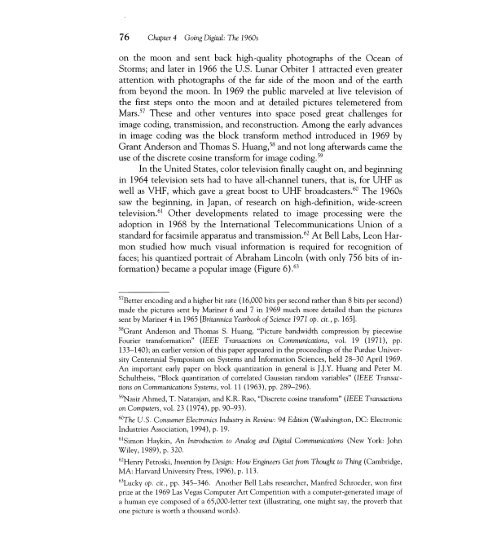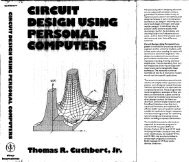Going Digital: The 1960s - IEEE Global History Network
Going Digital: The 1960s - IEEE Global History Network
Going Digital: The 1960s - IEEE Global History Network
You also want an ePaper? Increase the reach of your titles
YUMPU automatically turns print PDFs into web optimized ePapers that Google loves.
76 Chapter 4 <strong>Going</strong> <strong>Digital</strong>: <strong>The</strong> <strong>1960s</strong><br />
on the moon and sent back high..quality photographs of the Ocean of<br />
Storms; and later in 1966 the u.S. Lunar Orbiter 1 attracted even greater<br />
attention with photographs of the far side of the moon and of the earth<br />
from beyond the moon. In 1969 the public marveled at live television of<br />
the first steps onto the moon and at detailed pictures telemetered from<br />
Mars. 57 <strong>The</strong>se and other ventures into space posed great challenges for<br />
image coding, transmission, and reconstruction. Among the early advances<br />
in image coding was the block transform method introduced in 1969 by<br />
Grant Anderson and Thomas S. Huang,58 and not long afterwards came the<br />
use of the discrete cosine transform for image coding.59<br />
In the United States, color television finally caught on, and beginning<br />
in 1964 television sets had to have all..channel tuners, that is, for UHF as<br />
well as VHF, which gave a great boost to UHF broadcasters. 6o <strong>The</strong> <strong>1960s</strong><br />
saw the beginning, in Japan, of research on high..definition, wide..screen<br />
television. 61 Other developments related to image processing were the<br />
adoption in 1968 by the International Telecommunications Union of a<br />
standard for facsimile apparatus and transmission. 62 At Bell Labs, Leon Har..<br />
mon studied how much visual information is required for recognition of<br />
faces; his quantized portrait of Abraham Lincoln (with only 756 bits of in..<br />
formation) became a popular image (Figure 6).63<br />
57Better encoding and a higher bit rate (16,000 bits per second rather than 8 bits per second)<br />
made the pictures sent by Mariner 6 and 7 in 1969 much more detailed than the pictures<br />
sent by Mariner 4 in 1965 [Britannica Yearbook of Science 1971 op. cit., p. 165].<br />
58Grant Anderson and Thomas S. Huang, "Picture bandwidth compression by piecewise<br />
Fourier transformation" (<strong>IEEE</strong> Transactions on Communications, vol. 19 (1971), pp.<br />
133-140); an earlier version of this paper appeared in the proceedings of the Purdue Univer,<br />
sity Centennial Symposium on Systems and Information Sciences, held 28-30 April 1969.<br />
An important early paper on block quantization in general is J.J .Y. Huang and Peter M.<br />
Schultheiss, "Block quantization of correlated Gaussian random variables" (<strong>IEEE</strong> Transac-<br />
tions on Communications Systems, vol. 11 (1963), pp. 289-296).<br />
5~asir Ahmed, T. Natarajan, and K.R. Rao, "Discrete cosine transform" (<strong>IEEE</strong> Transactions<br />
on Computers, vol. 23 (1974), pp. 90-93).<br />
60<strong>The</strong> U.S. Consumer Electronics Industry in Review: 94 Edition (Washington, DC: Electronic<br />
Industries Association, 1994), p. 19.<br />
61Simon Haykin, An Introduction to Analog and <strong>Digital</strong> Communications (New York: John<br />
Wiley, 1989), p. 320.<br />
62Henry Petroski, Invention by Design: How Engineers Get from Thought to Thing (Cambridge,<br />
MA: Harvard University Press, 1996), p. 113.<br />
63Lucky op. cit., pp. 345-346. Another Bell Labs researcher, Manfred Schroeder, won first<br />
prize at the 1969 Las Vegas Computer Art Competition with a computer,generated image of<br />
a human eye composed of a 65,000,letter text (illustrating, one might say, the proverb that<br />
one picture is worth a thousand words).
















